Atmospheric Optics
Light is all around us, from both natural and artificial sources, during the day and the night. We think we understand it, and that what we see by it is an exact representation of what we are looking at. However we can be mistaken; the setting sun seen on the horizon has in fact already dropped below the horizon. Twinkling stars are also an effect of this same process, called refraction.
Light passing through a medium such as air or water can be absorbed and scattered by the molecules in the medium or refracted by changes in air density. Earth's atmosphere contains air, water and dust molecules that cause light rays from the sun to change direction as they pass through slightly different densities of air - this is known as refraction. The amount of refraction of light is dependent on the refractive index (a measure of how much a substance bends light, dependent on its density and the type of molecules) and the incident angle at which the light enters the substance. Denser substances such as water will bend the light more than a less dense substance like air, and light entering a substance at an angle will refract more than entering perpendicular to the substance's surface. Air itself can have different indices- air that is warm will be less dense and so will refract light less.
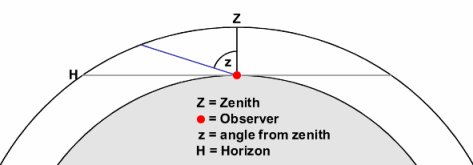 Looking up in the direction of the zenith, an observer will look through one air mass- ie the minimum amount of air that light from the sun will travel through to the surface. Light at an angle z from the zenith will pass through more air, so travels through an equivalently greater air mass at a greater incidence angle z. Roughly, the air mass varies with secant z,
Looking up in the direction of the zenith, an observer will look through one air mass- ie the minimum amount of air that light from the sun will travel through to the surface. Light at an angle z from the zenith will pass through more air, so travels through an equivalently greater air mass at a greater incidence angle z. Roughly, the air mass varies with secant z,
as cos(z)=1 airmass / n airmasses in a first-order case,
although for large angles (for more than about 60 degrees) away from the zenith, this is less accurate due to the spherical nature of the atmosphere. At the horizon, light will travel through a maximum of about 38 air masses to reach an observer at sea level.

However if the observer is above sea level, for example on a mountain or in a plane, the air mass can be greater than 38, due to the line-of-sight passing through more air before reaching the observer's horizon.
This change in air mass depending on where an observer looks in the sky changes the amount and type of light reaching the observer's position. Rayleigh (1871) found that the probability of a single photon (or packet of light energy) being scattered by an air molecule was inversely proportional to its wavelength to the fourth power. Blue light with a wavelength of about 450nm has more chance of being scattered than red light at 660nm. Light (especially the blue end of the spectrum) travelling through a greater air mass will be scattered more as there is more chance of encountering particles over this larger volume in the line-of-sight. The consequences of this are that the sun (as a single source) appears dimmer and redder near the horizon than from the zenith, as more light, especially bluer light, is scattered out of the line-of-sight to the observer. At zenith the sun's light is not scattered as much and so only a little blue light is lost- the sun appears white or slightly yellow. Conversely skylight (light from the sun scattered onto air and water molecules and so arriving at the observer from a direction other than the sun) looks bluer as it is mostly the blue light that is scattered in all directions that reaches the observer.
Viewing Astronomical Objects
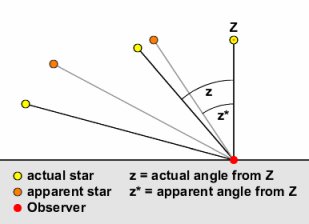
The light from stars and other objects such as the sun, moon and planets is also subject to these refractive properties which can cause the objects to appear higher in the sky than they actually are.
Again, light from stars near the horizon passes through a larger volume of air at a larger incidence angle than near the zenith, therefore encountering more changes in air density and so refracts more. The observer's eyes see the star where the light appears to be coming from, not the origin of the convoluted path that it actually takes. The closer to the horizon the star is, the greater amount of refraction we see and the greater disparity in apparent position.
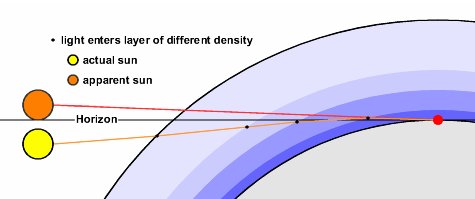
Consequently the sun or any celestial object setting on the horizon will be refracted the largest amount. As mentioned before, the angle of refraction is great enough that an observer can see the sun when it is actually below the horizon. The disk of the sun has an angular distance of about 30 arcminutes (or half a degree). The index of refraction for dry air at sea level is about 1.0002941, which means that the amount of refraction in dry air is also quite small - about 39 arcmins, but enough that as the bottom of the sun's disk is seen to touch the horizon, the top is actually 9 arcmins below the horizon.
Twinkling Stars
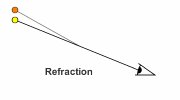
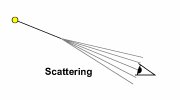 Refraction also occurs with small variations in air density due to uneven heating of the air (characterized by increased winds). This leads to small amounts of refraction of a star's light that an observer sees as twinkling (also known as scintillation). Again as the star's light travels through greater air mass near the horizon, the greatest twinkling is seen at the horizon.
Refraction also occurs with small variations in air density due to uneven heating of the air (characterized by increased winds). This leads to small amounts of refraction of a star's light that an observer sees as twinkling (also known as scintillation). Again as the star's light travels through greater air mass near the horizon, the greatest twinkling is seen at the horizon.
Two processes occur when looking at a star: light is momentarily refracted so as to appear to come from a slightly different position, and light is scattered in different directions, so decreasing the amount of light from the star that reaches the observer. These processes cause the star to appear to deviate slightly from its position, and to fade for split seconds of time, causing the star to twinkle.
Stars very near the horizon can also be seen to change colour momentarily. This is due to the light of different wavelengths (or colours) being dispersed different amounts by slight changes in the air. The star can appear any colour of the spectrum as the observer either sees the bluer light that is refracted or the redder light that is left or any colour in between before changing quickly again.
Objects with a measurable angular size such as the moon and planets do not appear to twinkle- this is due to the fact that light from the object is reaching the observer from all points on the object's disk. If one light ray is refracted out of line-of-sight, it does not make a noticeable difference to the observer, and light from the whole disk can not be deflected at the same time. There is also a chance that light from another point on the disk would be refracted into the line-of-sight so the intensity of light would not change.
An observer, therefore, can only be sure that what he is looking at is a true representation of an object if he is looking straight up to the zenith. Any view towards the horizon will be subject to increasing refractive and scattering effects, that can cause disparity in an object's position, changes in the colour of the incoming light and minute changes in the quality of light causing twinkling.
Sources:
David K Lynch and William Livingston; Color and Light in Nature, Cambridge University Press, 2nd Ed. 2001
Fraknoi, Morrison, Wolff; Voyages through the Universe, Saunders College Publishing, 2nd Ed. 2000
Scientific American: Ask The Experts
Astronomy Picture of the Day: Why Stars Twinkle
MATH 309 Project: Atmospheric Optics, 2003
 Hazel Grant
Hazel Grant
 Looking up in the direction of the zenith, an observer will look through one air mass- ie the minimum amount of air that light from the sun will travel through to the surface. Light at an angle z from the zenith will pass through more air, so travels through an equivalently greater air mass at a greater incidence angle z. Roughly, the air mass varies with secant z,
Looking up in the direction of the zenith, an observer will look through one air mass- ie the minimum amount of air that light from the sun will travel through to the surface. Light at an angle z from the zenith will pass through more air, so travels through an equivalently greater air mass at a greater incidence angle z. Roughly, the air mass varies with secant z, 



 Refraction also occurs with small variations in air density due to uneven heating of the air (characterized by increased winds). This leads to small amounts of refraction of a star's light that an observer sees as twinkling (also known as scintillation). Again as the star's light travels through greater air mass near the horizon, the greatest twinkling is seen at the horizon.
Refraction also occurs with small variations in air density due to uneven heating of the air (characterized by increased winds). This leads to small amounts of refraction of a star's light that an observer sees as twinkling (also known as scintillation). Again as the star's light travels through greater air mass near the horizon, the greatest twinkling is seen at the horizon.